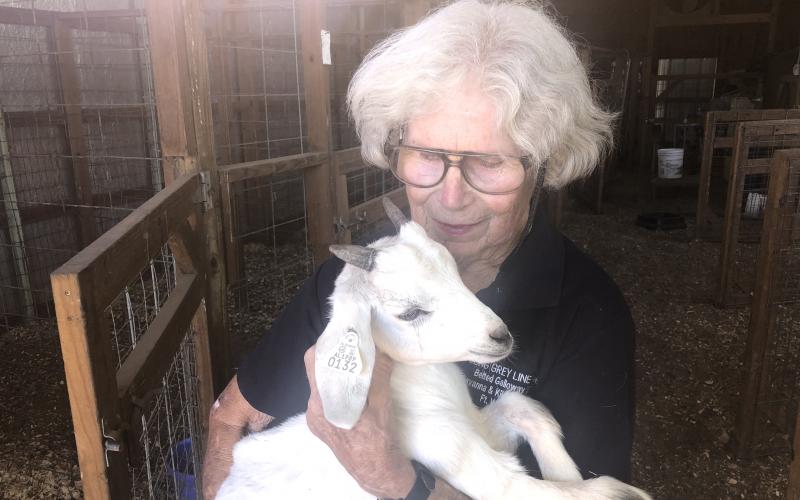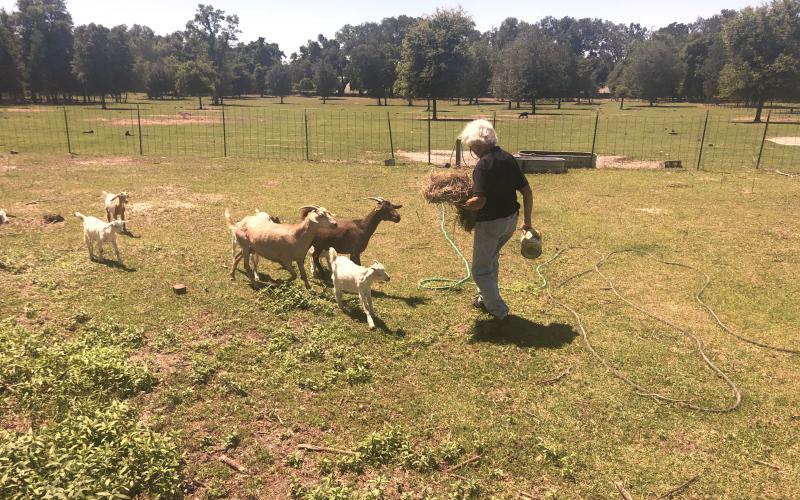Got goat?
As the nation braces for a shortage of beef, pork and chicken, Martha and Milt Aitken, owners of Long Grey Line Farm near Fort White, say goats may be the solution to satisfy America’s hunger for meat.
“It’s healthier, believe it or not,” Martha said. “We are one of the only countries in the world that doesn’t prominently eat goat.”
Late Thursday morning, Martha walked through the barn and unlatched all the doors, unleashing a herd of goats into the grazing area out back.
The 83-year-old woman picked up a bale of hay and looked for a good spot to feed the animals. Trailing behind her was an especially friendly goat equipped with a harness. It was born blind, Martha explained, and the harness allowed them to lead it around the property.
Martha rattled a coffee can full of something noisy to get the herd’s attention.
Just as she began to lower the hay to the ground, the hungry livestock swarmed around her.
The animals packed together so tightly it was hard to tell where one goat ended and another began.
A 6-week-old kid wandered away from the others and gently headbutted Martha’s leg.
The couple also raises cattle, but says goats are much easier.
“They’re economical if you want to get into livestock,” Martha said. “They are smaller, they consume less food and you can put more on an acre.”
They used to raise horses, as well, but that was too much work, Martha said.
“I’m too old to deal with horses,” she said.
Milt, 87, is a West Point graduate and retired U.S. Army officer. When he left the service, the husband and wife settled down in Huntsville, Alabama, where they lived for more than four decades and owned another farm.
Their daughter bought land in Columbia County about 10 years ago, Martha said. She wasn’t up for the long drive to visit her parents in Alabama, so the couple eventually decided to move to Florida.
The Aitken farm is adjacent to their daughter’s property.
In 2011, they made the switch to raising goats as their primary livestock.
The Sunshine State didn’t make the transition easy.
“Florida is a parasite haven,” Martha said. “I’ve never seen anything like the parasites you have here.”
By cross-breeding Kiko and Boer goats, the couple was able to make their livestock more resistant to parasites.
Goats are foraging animals, making them a little easier to maintain than other animals.
“But they’ll wipe out your orchard if you aren’t careful,” Martha quipped.
The couple spent a long time looking for the best strains of grass to plant, settling on native grass.
“For old people, that’s a challenge,” Martha said.
The Aitkens occasionally sell their livestock at auction in Ellisville, but mostly rely on direct-to-buyer transactions via the internet, Martha said. Their website is longgraylinefarm.com/.
So why hasn’t goat meat really caught on in the United States?
“The problem is goats are small,” Martha said. “You only get 20 pounds, maybe 30 pounds of meat.”
A goat bred to be used for meat can range from $150 to $200, she said. At the store, a pound of ground goat meat is about $9.
“The American consumer is kinda stumped with that because they can’t see that much benefit from an animal that is that small,” Martha said.
But it’s a better deal than it sounds, she said. Grass-fed beef is just as expensive as goat meat, which is also grass-fed.
“So proportionately, it’s not a bad buy,” Martha said.
Americans might not have much of a choice but finding alternatives to beef.
The meat industry is in a state of upheaval due to the covid-19 pandemic, with shortages looming.
Meat processing plants are operating on skeleton crews, and many have temporarily closed their doors in response to the crisis, potentially depriving the supply chain of millions of pounds of beef, pork and chicken.


